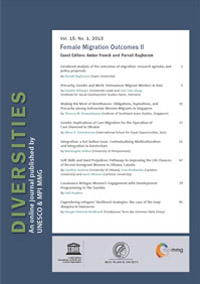Precarity, Gender and Work: Vietnamese Migrant Workers in Asia
by Danièle Bélanger (Université Laval) and Linh Tran Giang (Institute for Social Development Studies Hanoi, Vietnam)
Precarity among low-skilled temporary migrant workers in Asia is well documented, particularly concerning migrant women in domestic work in countries of the Gulf region and in East Asia. In this paper, we first examine the intersection of gender and type of work by comparing men and women, but also by comparing women engaged in domestic work and those working in manufacturing. Second, we analyse indicators of precarity through the entire migration process: pre-departure, time abroad, and return. Based on descriptive analyses from survey data collected in 2009 from 499 former Vietnamese migrant workers who worked in Malaysia, Taiwan, South Korea, and Japan between 2000 and 2009, our results indicate differences in (1) moments of precarity, (2) types of precarity, and (3) levels of precarity. This paper unpacks how gender is central to an understanding of precariousness in migration but also how it may intersect with other important variables.
Suggested bibliographic reference for this article:
Bélanger, D., & Giang, L.T. (2013). Precarity, Gender and Work: Vietnamese Migrant Workers in Asia. Diversities, 15(1), 5-20. Retrieved [todaysdate] from https://newdiversities.mmg.mpg.de/?page_id=1849
|
